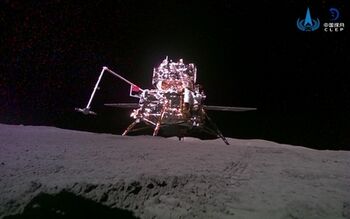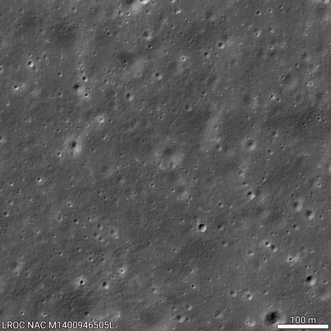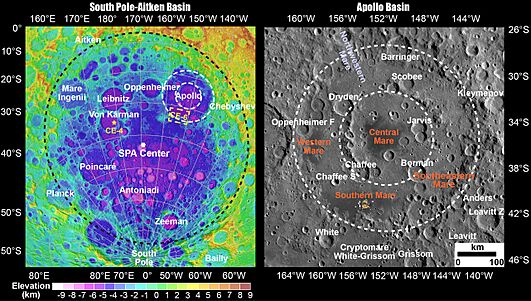Chang'e 6 facts for kids

The Chang'e 6 lander (with the ascender on top) on the far side of the Moon. The photo was taken from a mobile camera that was released from the lander
|
|
| Mission type | Surface sample return |
|---|---|
| Operator | CNSA |
| Mission duration | 52 days, 20 hours and 39 minutes |
| Spacecraft properties | |
| Manufacturer | CAST |
| Launch mass | 8,350 kg (18,410 lb) |
| Start of mission | |
| Launch date | 3 May 2024 09:27:29 UTC |
| Rocket | Long March 5 |
| Launch site | Wenchang |
| End of mission | |
| Landing date | 25 June 2024 06:07 UTC Return capsule |
| Landing site | Inner Mongolia, China |
| Lunar orbiter | |
| Orbital insertion | 8 May 2024 02:12 UTC |
| Orbital departure | 20 June 2024 ~15:00 UTC |
| Orbit parameters | |
| Periapsis | 220 km (140 mi) |
| Inclination | 137° |
| Lunar lander | |
| Landing date | 1 June 2024 22:23:16 UTC |
| Return launch | 3 June 2024 23:38:10 UTC |
| Landing site | Southern mare of Apollo Basin 41°38′19″S 153°59′07″W / 41.6385°S 153.9852°W |
| Lunar rover | |
| Landing date | 1 June 2024 22:23:16 UTC |
| Landing site | Southern mare of Apollo Basin |
| Docking with Sample Ascender | |
| Docking date | 6 June 2024 06:48 UTC |
| Undocking date | 6 June 2024 |
|
Chinese Lunar Exploration Program
|
|
Chang'e 6 (Chinese: 嫦娥六号; pinyin: Cháng'é liùhào) was a robotic lunar exploration mission by the China National Space Administration. Like its predecessors in the Chinese Lunar Exploration Program, the spacecraft is named after the Chinese moon goddess Chang'e.
The mission began on 3 May 2024 when the probe was launched from China's Hainan island. The mission's lander and a mobile camera rover landed on the far side of the Moon on 1 June 2024. As part of China's second sample return mission, the lander's robotic scoop and drill took samples from the lunar surface and placed it on the mission's ascender module which then was launched into lunar orbit on 3 June 2024. The ascender docked with the orbiter module in lunar orbit on 6 June 2024, then transferred the container carrying the samples to an atmospheric re-entry module on the orbiter for its eventual return to Earth. The mission's lander and mini-rover also conducted scientific experiments on the lunar surface. The overall mission lasted about 53 days, ending on 25 June 2024.
Contents
Overview
The Chinese Lunar Exploration Program is designed to be conducted in four phases of incremental technological advancement:
- The goal of the first phase was to reach lunar orbit. This was completed by Chang'e 1 in 2007 and by Chang'e 2 in 2010.
- The second phase sought to land and rove on the Moon, a feat that was accomplished by Chang'e 3 in 2013 and by Chang'e 4 in 2019.
- The third phase involves the collection of lunar samples and sending them to Earth, first completed by Chang'e 5 in 2020 and in progress by Chang'e 6.
- The fourth phase consists of the development of a robotic research station near the Moon's south pole. The program aims to facilitate crewed lunar landings in the 2030s and possibly build a crewed outpost near the lunar south pole.
The preceding Chang'e 5 mission returned 1.731 kilograms (3.82 lb) of material from the northern hemisphere of the lunar near side.
The Chang'e 6 mission landed on the southern hemisphere of the lunar far side to gather more material. Specifically, the landing segment of the Chang'e 6 mission touched down in a relatively flat area lying in the southern portion of the Apollo crater, which itself lies within the larger South Pole-Aitken (SPA) impact basin on the lunar far side. Scientists hope that the samples collected from the landing area may include lunar mantle material ejected by the original impact that created the SPA basin, material which can shed light on the differences that exist between the lunar near-side and far-side, and on the origin of the Moon and the Solar System..
The Chang'e 6 lander landed at 22:23 UTC on 1 June 2024 in the southern mare of Apollo Basin (lunar coordinates: 41°38′19″S 153°59′07″W / 41.6385°S 153.9852°W). After the completion of sample collection and the placement of the sample on the ascender by the probe's robotic drill and robotic arm, the ascender successfully took off from atop the lander portion of the probe at 23:38 UTC on 3 June 2024. The ascender docked with the Chang'e 6 service module (the orbiter) in lunar orbit at 06:48 UTC on 6 June 2024 and subsequently completed the transfer of the sample container to the Earth return module at 07:24 UTC on the same day. On 25 June 2024, the return capsule successfully landed in Inner Mongolia.
The mission's lander collected approximately 2 kilograms (4.4 lb) of lunar far-side material including surface soil and rocks (using a scoop) and subsurface samples (using a drill). If the mission is fully successful, China will be the first nation to bring back samples from the far side of the Moon.
The hole left by the sampling was in the shape of the character zhong (中) which is the initial character of China's name Zhōngguó 中国. This symbolism went viral on Weibo.
Mission architecture
Chang'e 6 was built as a copy of and backup to Chang'e 5. The mission is reported to consist of four modules:
- Lander: landed on the lunar surface after separating from the Orbiter, equipped with a drill and a scooping device. The Ascender was on the top of the Lander. It collected about 2 kg (4.4 lb) of samples from 2 metres (6.6 ft) below the surface and placed them in the attached ascent vehicle to be launched into lunar orbit.
- Ascender: The ascent vehicle then made a fully autonomous and robotic Lunar orbit rendezvous and docking with Orbiter where the samples were robotically transferred into a sample-return capsule for their delivery to Earth.
- Orbiter: after the samples were transported from the Ascender to the Orbiter, the Orbiter left lunar orbit and spent ~4.5 days flying back to Earth orbit and released the Returner (reentry capsule) just before arrival.
- Returner: The Returner will perform a skip reentry to bounce off the atmosphere once before formal reentering.
The estimated launch mass is 8,200 kg (18,100 lb)—the lander is projected to be 3,200 kg (7,100 lb) and the ascent vehicle is about 700 kg (1,500 lb).
Science payloads
In October 2018, Chinese officials announced that they would call for international partners to propose an additional payload up to 10 kg (22 lb) to be included in this mission. In November 2022, it was announced that the mission would carry payloads from four international partners:
Lander
- A French instrument called DORN (Detection of Outgassing Radon) to study the transport of lunar dust and other volatiles between the lunar regolith and the lunar exosphere, including the water cycle.
- The Italian instrument INRRI (INstrument for landing-Roving laser Retroreflector Investigations) consists of a retroreflector that precisely measures distances from the lander to orbit, similar to those used in the Schiaparelli and InSight missions.
- The Swedish NILS (Negative Ions on Lunar Surface), an instrument to detect and measure negative ions reflected by the lunar surface.
Orbiter
- The Pakistani ICUBE-Q CubeSat orbiter developed by the Institute of Space Technology in collaboration with Shanghai Jiao Tong University, which carries two optical cameras to image the lunar surface and obtain lunar magnetic field data.
Rover
Chang'e-6 carries a "previously undisclosed" mini rover described as a Mobile Camera. The rover is expected to support research into the composition of the lunar surface, the presence of water ice in the lunar soil via an imaging infrared spectrometer and image the Chang'e 6 lander on the lunar surface.
Mission profile
Launch

The probe was launched by a Long March 5 rocket at 09:27 UTC, on 3 May 2024, from Wenchang Satellite Launch Center on Hainan Island.
Earth-Moon transfer
After launch, Chang'e 6 successfully entered a 12-hour orbit around the Moon at 02:12 UTC, on 8 May 2024.
The lander/ascender/rover separated from the orbiter/returner on 30 May 2024, in preparation for landing.
Landing
At 22:06 UTC, on 1 June 2024, the Chang'e 6 lander/ascender, with the support of the Queqiao-2 relay satellite, descended from its 200 kilometer (124 miles) orbit altitude. It used its autonomous obstacle avoidance system, visible light camera, and laser 3D scanner to detect and avoid lunar obstacles and uneven terrain. At 22:23 UTC, it successfully landed in the pre-selected landing area in the South Pole–Aitken basin on the far side of the Moon. The engine was cut for the final approach and a cushioning system was used for the freefall touchdown.
Return
At 23:38 UTC on 3 June 2024, the Chang'e 6 ascender (carrying the samples) took off from the far side of the Moon and entered the predetermined circumlunar orbit. This was the world's first sampling and takeoff on the far side of the Moon.
At 06:48 UTC on 6 June, 2024, the Chang'e 6 ascender rendezvoused and docked with the orbiter/returner in lunar orbit. At 07:24 UTC, the lunar sample container was safely transferred to the returner.
On 21 June 2024, the service module of Chang'e 6 likely fired its engines to return to Earth from lunar orbit. CNSA has not provided an updates on the mission, however optical and radio amateur observations showed a probable engine burning.
On 25 June 2024, at 06:07 UTC, the return capsule successfully landed in the pre-designated area of Siziwang Banner, Inner Mongolia.
See also
 In Spanish: Chang'e 6 para niños
In Spanish: Chang'e 6 para niños
- Lunar resources
- Lunar water
- VIPER (rover)
- Luna 27
- LUPEX


